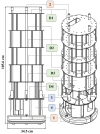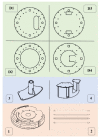Low-Cost UVBot Using SLAM to Mitigate the Spread of Noroviruses in Occupational Spaces
- PMID: 36433523
- PMCID: PMC9696947
- DOI: 10.3390/s22228926
Low-Cost UVBot Using SLAM to Mitigate the Spread of Noroviruses in Occupational Spaces
Abstract
Noroviruses (NoVs) cause over 90% of non-bacterial gastroenteritis outbreaks in adults and children in developed countries. Therefore, there is a need for approaches to mitigate the transmission of noroviruses in workplaces to reduce their substantial health burden. We developed and validated a low-cost, autonomous robot called the UVBot to disinfect occupational spaces using ultraviolet (UV) lamps. The total cost of the UVBOT is less than USD 1000, which is much lower than existing commercial robots that cost as much as USD 35,000. The user-friendly desktop application allows users to control the robot remotely, check the disinfection map, and add virtual walls to the map. A 2D LiDAR and a simultaneous localization and mapping (SLAM) algorithm was used to generate a map of the space being disinfected. Tulane virus (TV), a human norovirus surrogate, was used to validate the UVBot's effectiveness. TV was deposited on a painted drywall and exposed to UV radiation at different doses. A 3-log (99.9%) reduction of TV infectivity was achieved at a UV dose of 45 mJ/cm2. We further calculated the sanitizing speed as 3.5 cm/s and the efficient sanitizing distance reached up to 40 cm from the UV bulb. The design, software, and environment test data are available to the public so that any organization with minimal engineering capabilities can reproduce the UVBot system.
Keywords: SLAM; UV light; autonomous robot; norovirus; robot disinfection.
Conflict of interest statement
The authors declare that the research was conducted in the absence of any commercial or financial relationships that could be construed as a potential conflict of interest.
Figures












Similar articles
-
Ultraviolet Light Inactivation of Murine Norovirus and Human Norovirus GII: PCR May Overestimate the Persistence of Noroviruses Even When Combined with Pre-PCR Treatments.Food Environ Virol. 2014 Mar;6(1):48-57. doi: 10.1007/s12560-013-9128-y. Epub 2013 Oct 19. Food Environ Virol. 2014. PMID: 24142397
-
UV Inactivation of Rotavirus and Tulane Virus Targets Different Components of the Virions.Appl Environ Microbiol. 2020 Feb 3;86(4):e02436-19. doi: 10.1128/AEM.02436-19. Print 2020 Feb 3. Appl Environ Microbiol. 2020. PMID: 31811032 Free PMC article.
-
Infectivity reduction efficacy of UV irradiation and peracetic acid-UV combined treatment on MS2 bacteriophage and murine norovirus in secondary wastewater effluent.J Environ Manage. 2018 Sep 1;221:1-9. doi: 10.1016/j.jenvman.2018.04.064. Epub 2018 May 26. J Environ Manage. 2018. PMID: 29793207
-
Retention of Virus Versus Surrogate, by Ultrafiltration in Seawater: Case Study of Norovirus Versus Tulane.Food Environ Virol. 2024 Mar;16(1):14-24. doi: 10.1007/s12560-023-09574-z. Epub 2024 Jan 6. Food Environ Virol. 2024. PMID: 38184502 Review.
-
Norovirus Gastroenteritis Outbreaks, Genomic Diversity and Evolution: An Overview.Mymensingh Med J. 2021 Jul;30(3):863-873. Mymensingh Med J. 2021. PMID: 34226482 Review.
Cited by
-
Coverage Planning for UVC Irradiation: Robot Surface Disinfection Based on Swarm Intelligence Algorithm.Sensors (Basel). 2024 May 26;24(11):3418. doi: 10.3390/s24113418. Sensors (Basel). 2024. PMID: 38894209 Free PMC article.
References
-
- Dyal J.W., Grant M.P., Broadwater K., Bjork A., Waltenburg M.A., Gibbins J.D., Hale C., Silver M., Fischer M., Steinberg J., et al. COVID-19 among Workers in Meat and Poultry Processing Facilities—19 States, April 2020. MMWR Morb. Mortal. Wkly. Rep. 2020;69:887–892. doi: 10.15585/mmwr.mm6918e3. - DOI - PMC - PubMed
-
- Marshall K., Vahey G.M., McDonald E., Tate J.E., Herlihy R., Midgley C.M., Kawasaki B., Killerby M.E., Alden N.B., Staples J.E. Exposures Before Issuance of Stay-at-Home Orders Among Persons with Laboratory-Confirmed COVID-19—Colorado, March 2020. MMWR Morb. Mortal. Wkly. Rep. 2020;69:847–849. doi: 10.15585/mmwr.mm6926e4. - DOI - PMC - PubMed
-
- Centers for Disease Control and Prevention CDC Recurring norovirus outbreaks in a long-term residential treatment facility—Oregon, 2007. MMWR Morb. Mortal. Wkly. Rep. 2009;58:694–698. - PubMed
MeSH terms
Grants and funding
LinkOut - more resources
Full Text Sources
Medical

